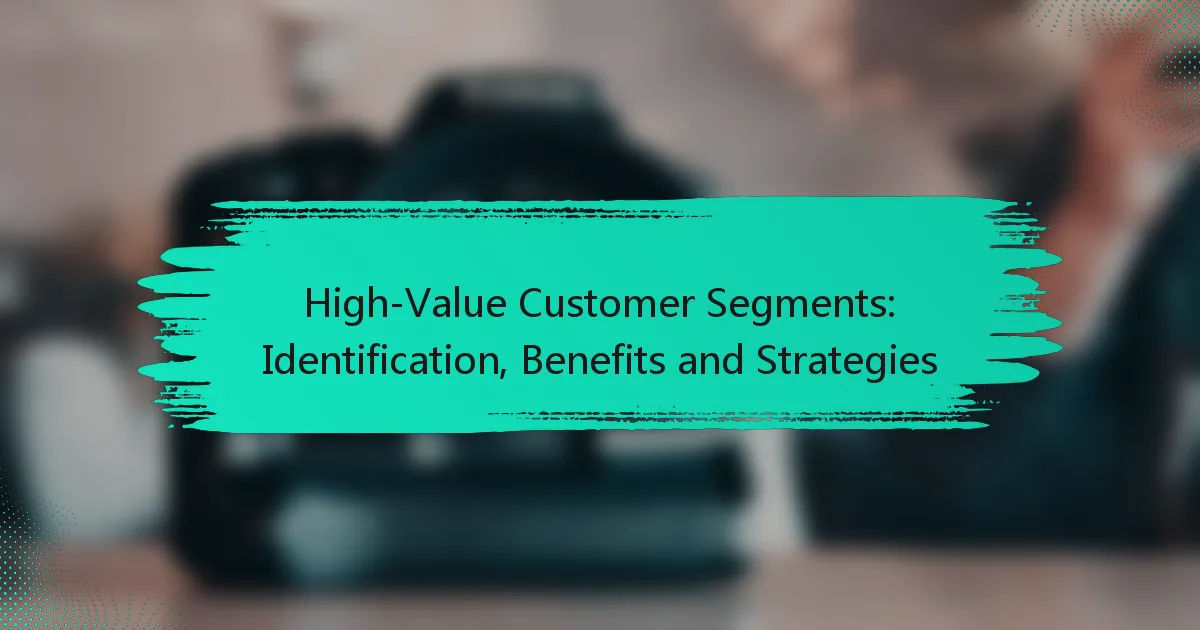Identifying high-value customer segments in Latvia is crucial for businesses aiming to enhance profitability and strengthen customer relationships. By analyzing demographics, behaviors, and customer lifetime value, companies can develop tailored strategies that resonate with their most profitable customers. Engaging these segments through personalized marketing and loyalty programs can significantly optimize resources and improve overall performance.

How to identify high-value customer segments in Latvia?
Identifying high-value customer segments in Latvia involves analyzing various factors such as demographics, behaviors, and customer lifetime value. By focusing on these aspects, businesses can tailor their strategies to attract and retain their most profitable customers.
Demographic analysis
Demographic analysis helps businesses understand the characteristics of their customer base, including age, gender, income, and education level. In Latvia, for example, targeting specific age groups or income brackets can reveal lucrative segments. Companies should gather data from surveys and public statistics to create detailed customer profiles.
Consider segmenting customers into groups such as young professionals, families, or retirees. Each group may have different needs and preferences, allowing for more effective marketing strategies.
Behavioral segmentation
Behavioral segmentation focuses on customer actions, such as purchasing habits, brand loyalty, and product usage. By analyzing these behaviors, businesses can identify which customers are more likely to make repeat purchases or respond to promotions. In Latvia, observing seasonal buying trends can also provide insights into customer preferences.
Utilizing tools like customer journey mapping can help visualize how customers interact with your brand, leading to better-targeted marketing efforts.
Customer lifetime value assessment
Assessing customer lifetime value (CLV) is crucial for identifying high-value segments. CLV estimates the total revenue a customer is expected to generate over their relationship with your business. In Latvia, businesses can calculate CLV by considering average purchase frequency and average order value.
Focusing on customers with high CLV allows companies to allocate resources effectively, ensuring that marketing efforts are directed toward retaining these valuable segments.
Market research tools
Utilizing market research tools can significantly enhance the identification of high-value customer segments. Tools such as surveys, focus groups, and online analytics provide valuable insights into customer preferences and behaviors. In Latvia, platforms like Google Surveys or local market research firms can help gather relevant data.
Regularly updating market research ensures that businesses stay informed about changing customer needs and market trends, allowing for timely adjustments to strategies.
Data analytics platforms
Data analytics platforms play a vital role in identifying high-value customer segments by processing large volumes of data to uncover patterns and trends. Tools like Google Analytics, Tableau, or local Latvian solutions can help businesses analyze customer data effectively.
Implementing these platforms allows companies to segment their customer base based on various criteria, enabling more personalized marketing efforts and improved customer engagement.
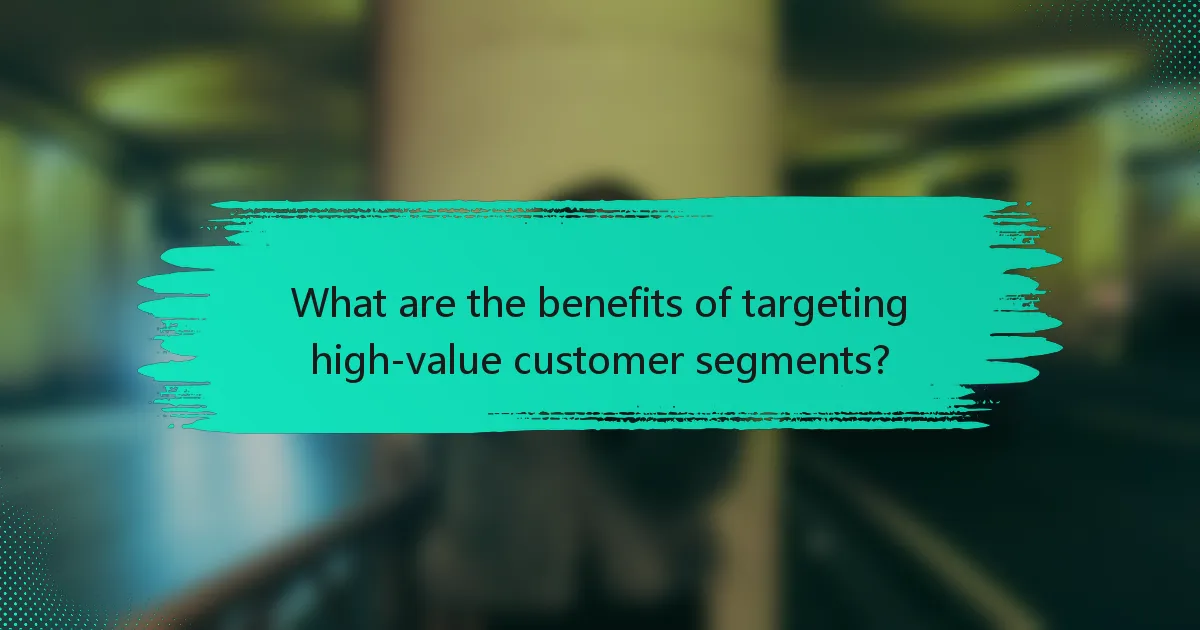
What are the benefits of targeting high-value customer segments?
Targeting high-value customer segments leads to significant advantages for businesses, including increased profitability and stronger customer relationships. By focusing on these segments, companies can optimize their resources and enhance overall performance.
Increased ROI
Focusing on high-value customer segments typically results in a higher return on investment (ROI). These customers often generate more revenue, allowing businesses to allocate marketing budgets more effectively. For instance, investing in personalized marketing strategies for these segments can yield returns that are several times higher than average.
To maximize ROI, businesses should analyze customer data to identify high-value segments and tailor their offerings accordingly. This targeted approach can lead to more efficient use of marketing resources and improved financial outcomes.
Enhanced customer loyalty
High-value customer segments tend to exhibit greater loyalty, which is crucial for long-term success. When businesses cater to the specific needs and preferences of these customers, they foster a sense of connection and trust. This can lead to repeat purchases and positive word-of-mouth referrals.
To enhance loyalty, companies should implement loyalty programs or exclusive offers that resonate with these segments. Engaging with customers through personalized communication can also strengthen relationships and encourage ongoing patronage.
Improved marketing efficiency
Targeting high-value customer segments improves marketing efficiency by allowing businesses to focus their efforts on the most profitable groups. This strategic focus reduces wasted resources on less lucrative segments and enhances the effectiveness of marketing campaigns.
Utilizing data analytics tools can help identify these segments and refine marketing messages. By understanding customer behavior and preferences, businesses can create more relevant content that drives engagement and conversion.
Higher conversion rates
High-value customer segments often exhibit higher conversion rates compared to other groups. This is primarily due to their established interest in the brand and its offerings, making them more likely to complete purchases. By targeting these segments, businesses can significantly boost their sales figures.
To achieve higher conversion rates, companies should employ targeted advertising and personalized experiences that resonate with these customers. A/B testing different approaches can help identify the most effective strategies for converting high-value leads into loyal customers.
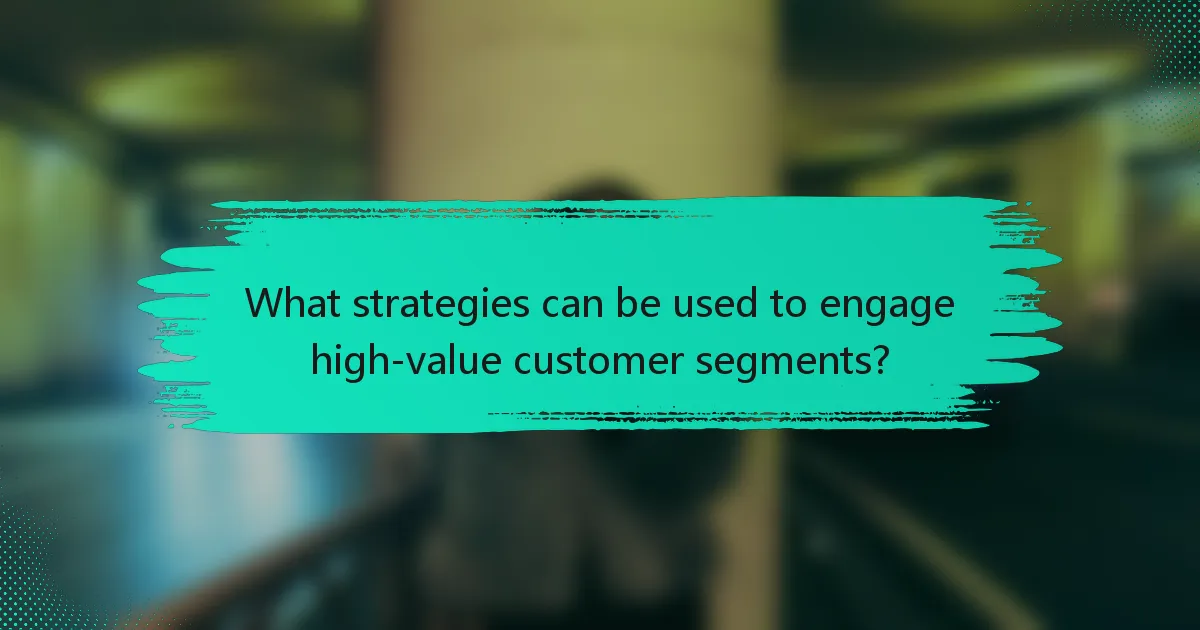
What strategies can be used to engage high-value customer segments?
Engaging high-value customer segments requires tailored approaches that resonate with their specific needs and preferences. Effective strategies include personalized marketing, loyalty programs, gathering customer feedback, and creating targeted content.
Personalized marketing campaigns
Personalized marketing campaigns focus on delivering tailored messages and offers to high-value customers based on their behavior and preferences. This can involve using data analytics to segment customers and create customized email campaigns or targeted ads that speak directly to their interests.
For example, a retail brand might analyze purchase history to recommend products that align with a customer’s previous choices. This approach can significantly enhance engagement and conversion rates, making customers feel valued and understood.
Loyalty programs
Loyalty programs incentivize high-value customers to continue their relationship with a brand by offering rewards for repeat purchases. These programs can include points systems, exclusive discounts, or early access to new products, which encourage ongoing patronage.
Implementing a tiered loyalty program can further enhance effectiveness, where customers unlock greater rewards as they spend more. This not only boosts customer retention but also increases the average transaction value, benefiting the business overall.
Customer feedback loops
Establishing customer feedback loops allows businesses to gather insights directly from high-value customers about their experiences and preferences. This can be achieved through surveys, interviews, or feedback forms, enabling companies to adapt their offerings based on real customer input.
Regularly soliciting feedback not only helps improve products and services but also makes customers feel involved and valued. It is essential to act on this feedback and communicate changes to customers, reinforcing their importance to the brand.
Targeted content creation
Targeted content creation involves developing content that specifically addresses the interests and needs of high-value customer segments. This can include blog posts, videos, or social media content that provides value and engages customers on topics they care about.
For instance, a financial services company might create educational content about investment strategies tailored to affluent clients. This not only positions the brand as an authority but also fosters a deeper connection with the audience, encouraging loyalty and trust.
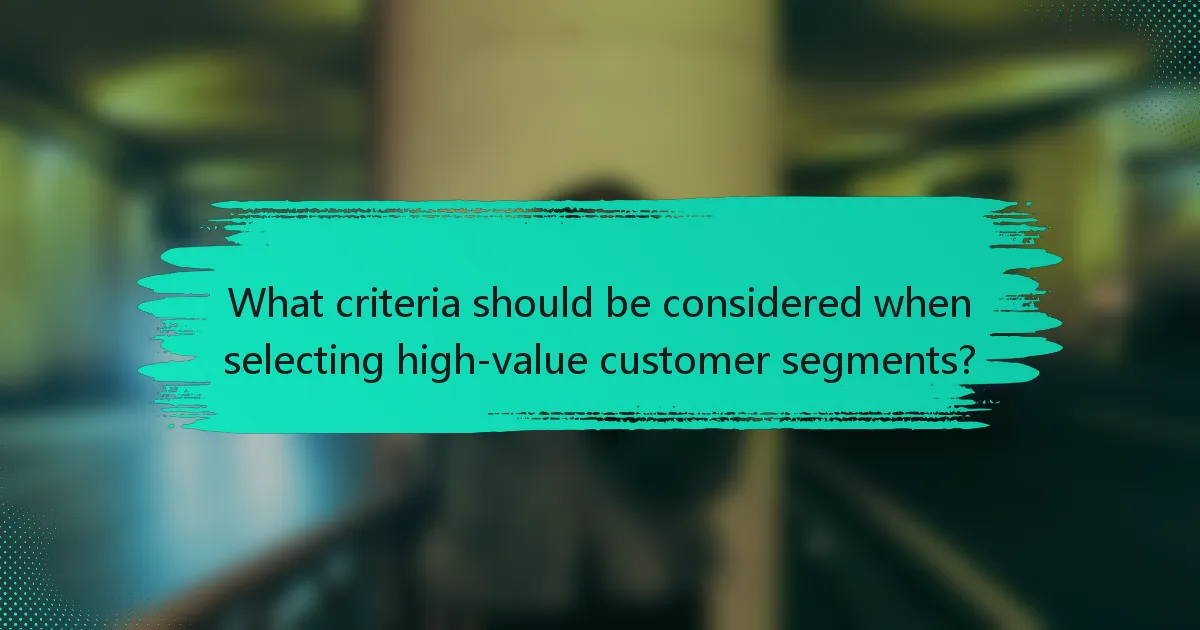
What criteria should be considered when selecting high-value customer segments?
When selecting high-value customer segments, consider factors such as market potential, competitive landscape, and customer needs and preferences. These criteria help identify segments that can drive significant revenue and foster long-term loyalty.
Market potential
Market potential refers to the size and growth prospects of a customer segment. Evaluate the total addressable market (TAM) and the segment’s projected growth rate to determine its viability. For instance, a segment with a TAM of several million euros and a growth rate exceeding 10% annually may be worth targeting.
Additionally, assess geographic factors that could influence market potential. For example, urban areas may present higher opportunities due to greater disposable income and demand for premium products.
Competitive landscape
Understanding the competitive landscape is crucial for identifying high-value segments. Analyze the number of competitors, their market share, and the level of differentiation in the offerings. A segment with few competitors may offer a better chance for market penetration.
Consider conducting a SWOT analysis (Strengths, Weaknesses, Opportunities, Threats) to evaluate your position relative to competitors. This can help identify unique selling propositions that can attract high-value customers.
Customer needs and preferences
Identifying customer needs and preferences is essential for tailoring products and services to high-value segments. Conduct surveys or focus groups to gather insights on what drives purchasing decisions, such as quality, price, or brand reputation.
Segment customers based on their preferences, such as eco-friendliness or luxury features, to create targeted marketing strategies. For example, a segment that prioritizes sustainability may respond well to environmentally friendly products, enhancing customer loyalty and satisfaction.
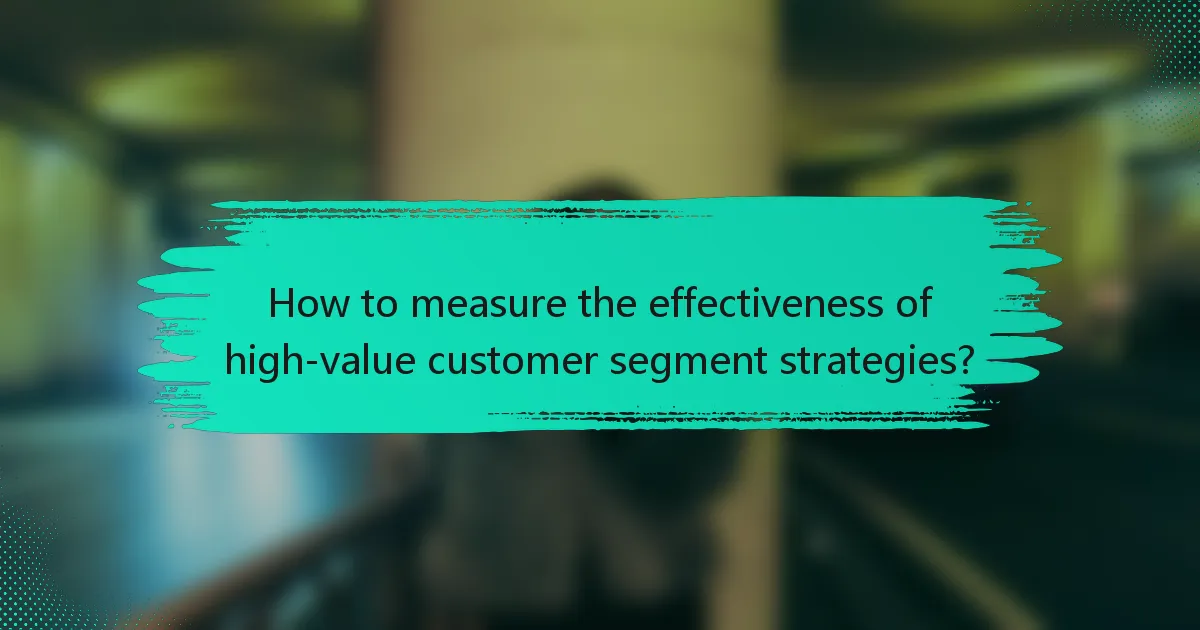
How to measure the effectiveness of high-value customer segment strategies?
Measuring the effectiveness of high-value customer segment strategies involves analyzing specific metrics that indicate how well these strategies are performing. Key metrics include customer retention rates, revenue per customer, and overall satisfaction levels, which can provide insights into the success of targeting high-value segments.
Key performance indicators (KPIs)
Key performance indicators (KPIs) are essential for assessing the effectiveness of high-value customer segment strategies. Common KPIs include customer lifetime value (CLV), which estimates the total revenue a business can expect from a customer over their relationship, and customer acquisition cost (CAC), which measures the cost associated with acquiring a new customer.
To effectively track these KPIs, businesses should establish benchmarks based on historical data and industry standards. For instance, a CLV that is at least three times the CAC is often considered a healthy ratio. Regularly reviewing these metrics helps identify trends and areas for improvement.
Customer satisfaction surveys
Customer satisfaction surveys are a direct method for gauging how well high-value customer segments perceive your products or services. These surveys can include questions about overall satisfaction, likelihood to recommend, and specific feedback on features or services that matter most to these customers.
Implementing surveys at different touchpoints, such as after a purchase or following customer service interactions, can provide valuable insights. Aim for a response rate of around 10-30% for meaningful data, and consider using a mix of quantitative ratings and open-ended questions to capture both numerical scores and qualitative feedback.
